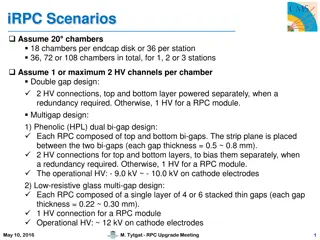Understanding Remote Procedure Call (RPC) in Operating Systems
Remote Procedure Call (RPC) in operating systems enables remote execution of procedures, facilitating communication between client and server machines. It involves information flow, addressing cross-platform issues, and dealing with non-atomic failures. Ensuring availability, durability, and reliability are key considerations in RPC implementation.
Download Presentation

Please find below an Image/Link to download the presentation.
The content on the website is provided AS IS for your information and personal use only. It may not be sold, licensed, or shared on other websites without obtaining consent from the author. Download presentation by click this link. If you encounter any issues during the download, it is possible that the publisher has removed the file from their server.
E N D
Presentation Transcript
CS6456: Graduate Operating Systems Brad Campbell bradjc@virginia.edu https://www.cs.virginia.edu/~bjc8c/class/cs6456-f19/ 1
Remote Procedure Call (RPC) Raw messaging is a bit too low-level for programming Must wrap up information into message at source Must decide what to do with message at destination May need to sit and wait for multiple messages to arrive Another option: Remote Procedure Call (RPC) Calls a procedure on a remote machine Client calls: remoteFileSystem Read("rutabaga"); Translated automatically into call on server: fileSys Read("rutabaga"); 2
RPC Information Flow bundle args call send Client (caller) Client Stub Packet Handler return receive unbundle ret vals mbox2 Network Network Machine A Machine B bundle ret vals mbox1 return send Server (callee) Server Stub Packet Handler call receive unbundle args 4
RPC Details Cross-platform issues: What if client/server machines are different architectures/ languages? Convert everything to/from some canonical form Tag every item with an indication of how it is encoded (avoids unnecessary conversions) 6
Problems with RPC: Non-Atomic Failures Different failure modes in dist. system than on a single machine Consider many different types of failures User-level bug causes address space to crash Machine failure, kernel bug causes all processes on same machine to fail Some machine is compromised by malicious party Before RPC: whole system would crash/die After RPC: One machine crashes/compromised while others keep working Can easily result in inconsistent view of the world Did my cached data get written back or not? Did server do what I requested or not? 7
Important ilities Availability: the ability of the system to accept and process requests Durability: the ability of a system to recover data despite faults Reliability: the ability of a system or component to perform its required functions under stated conditions for a specified period of time (IEEE definition) 10
Distributed: Why? Simple, cheaper components Easy to add capability incrementally Let multiple users cooperate (maybe) Physical components owned by different users Enable collaboration between diverse users 14
The Promise of Dist. Systems Availability: One machine goes down, overall system stays up Durability: One machine loses data, but system does not lose anything Security: Easier to secure each component of the system individually? 15
Distributed: Worst-Case Reality Availability: Failure in one machine brings down entire system Durability: Any machine can lose your data Security: More components means more points of attack 16
Distributed Systems Goal Transparency: Hide "distributed-ness" from any external observer, make system simpler Types Location: Location of resources is invisible Migration: Resources can move without user knowing Replication: Invisible extra copies of resources (for reliability, performance) Parallelism: Job split into multiple pieces, but looks like a single task Fault Tolerance: Components fail without users knowing 17
Challenge of Coordination Components communicate over the network Send messages between machines Need to use messages to agree on system state This issue does not exist in a centralized system 18
CAP Theorem Originally proposed by Eric Brewer (Berkeley) 1. Consistency changes appear to everyone in same sequential order 2. Availability can get a result at any time 3. Partition Tolerance system continues to work even when one part of network can't communicate with the other Impossible to achieve all 3 at the same time (pick two) 19
CAP Theorem Example What do we do if a network partition occurs? Prefer Availability: Allow the state at some nodes to disagree with the state at other nodes (AP) Prefer Consistency: Reject requests until the partition is resolved (CP) Partition B Partition A 20
Consistency Preferred Block writes until all nodes able to agree Consistent: Reads never return wrong values Not Available: Writes block until partition is resolved and unanimous approval is possible 21
What about AP Systems? Partition occurs, but both groups of nodes continue to accept requests Consequence: State might diverge between the two groups (e.g., different updates are executed) When communication is restored, there needs to be an explicit recovery process Resolve conflicting updates so everyone agrees on system state once again 22
Generals Paradox Two generals located on opposite sides of their enemy s position Can only communicate via messengers Messengers go through enemy territory: might be captured Problem: Need to coordinate time of attack Two generals lose unless they attack at same time If they attack at same time, they win 23
Generals Paradox Can messages over an unreliable network be used to guarantee two entities do something simultaneously? No, even if all messages go through General 1 General 2 24
Two-Phase Commit We can t solve the General s Paradox No simultaneous action But we can solve a related problem Distributed Transaction: Two (or more) machines agree to do something or not do itatomically Extra tool: Persistent Log If machine fails, it will remember what happened Assume log itself can t be corrupted 25
Two-Phase Commit: Setup One machine (coordinator) initiates the protocol It asks every machine to vote on transaction Two possible votes: Commit Abort Commit transaction only if unanimous approval 26
Two-Phase Commit: Preparing Agree to Commit Machine has guaranteed that it will accept transaction Must be recorded in log so machine will remember this decision if it fails and restarts Agree to Abort Machine has guaranteed that it will never accept this transaction Must be recorded in log so machine will remember this decision if it fails and restarts 27
Two-Phase Commit: Finishing Commit Transaction Coordinator learns all machines have agreed to commit Apply transaction, inform voters Record decision in local log Abort Transaction Coordinator learns at least on machine has voted to abort Do not apply transaction, inform voters Record decision in local log 28
Example: Failure-Free 2PC coordinator GLOBAL- COMMIT VOTE- REQ worker 1 worker 2 VOTE- COMMIT worker 3 time 33
Example: Failure-Free 2PC coordinator GLOBAL- ABORT VOTE- REQ VOTE- ABORT worker 1 worker 2 VOTE- COMMIT worker 3 time 34
Example of Worker Failure INIT WAIT timeout ABORT COMM coordinator GLOBAL- ABORT VOTE-REQ worker 1 VOTE- COMMIT worker 2 worker 3 time 35
Example of Coordinator Failure INIT READY ABORT COMM coordinator restarted VOTE-REQ worker 1 VOTE- COMMIT GLOBAL- ABORT worker 2 block waiting for coordinator worker 3 37
Paxos: fault tolerant agreement Paxos lets all nodes agree on the same value despite node failures, network failures and delays High-level process: One (or more) node decides to be the leader Leader proposes a value and solicits acceptance from others Leader announces result or try again 42
Google Spanner James C. Corbett, Jeffrey Dean, Michael Epstein, Andrew Fikes, Christopher Frost, J. J. Furman, Sanjay Ghemawat, Andrey Gubarev, Christopher Heiser, Peter Hochschild, Wilson Hsieh, Sebastian Kanthak, Eugene Kogan, Hongyi Li, Alexander Lloyd, Sergey Melnik, David Mwaura, David Nagle, Sean Quinlan, Rajesh Rao, Lindsay Rolig, Yasushi Saito, Michal Szymaniak, Christopher Taylor, Ruth Wang, and Dale Woodford. 2012. Spanner: Google's globally-distributed database. In Proceedings of the 10th USENIX conference on Operating Systems Design and Implementation (OSDI'12). USENIX Association, Berkeley, CA, USA, 251-264. 43
Basic Spanner Operation Data replicated across datacenters Paxos groups support transactions On commit: Grab Paxos lock Paxos algorithm decides consensus If all agree, transaction is committeed 44
Spanner Operation Paxos Paxos 2PC 45
Base operation great for writes What about reads? Reads are dominant operations e.g., FB s TAO had 500 reads : 1 write [ATC 2013] e.g., Google Ads (F1) on Spanner from 1? DC in 24h: 21.5B reads 31.2M single-shard transactions 32.1M multi-shard transactions Want efficient read transactions 46
Make Read-Only Txns Efficient Ideal: Read-only transactions that are non-blocking Arrive at shard, read data, send data back Goal 1: Lock-free read-only transactions Goal 2: Non-blocking stale read-only txns 47
TrueTime Global wall-clock time with bounded uncertainty is worst-case clock divergence Timestamps become intervals, not single values TT.now() time earliest latest 2* Consider event enow which invoked tt = TT.now(): Guarantee: tt.earliest <= tabs(enow) <= tt.latest 48
Timestamps and TrueTime Acquired locks Release locks T Pick s > TT.now().latest s Wait until TT.now().earliest > s Commit wait average average Key: Need to ensure that all future transactions will get a higher timestamp Commit wait ensures this 49
Commit Wait and Replication Start consensus Achieve consensus Notify followers Acquired locks Release locks T Pick s Commit wait done 50
Read-only optimizations Given global timestamp, can implement read-only transactions lock-free (snapshot isolation) Step 1: Choose timestamp sread = TT.now.latest() Step 2: Snapshot read (at sread) Can be served by any up-to-date replica 51
TrueTime for Read-Only Txns Assign all transactions a wall-clock commit time (s) All replicas of all shards track how up-to-date they are with tsafe: all transactions with s < tsafe have committed on this machine Goal 1: Lock-free read-only transactions Current time TT.now.latest() sread = TT.now.latest() wait until sread < tsafe Read data as of sread Goal 2: Non-blocking stale read-only txns Similar to above, except explicitly choose time in the past (Trades away consistency for better perf, e.g., lower latency) 52
Commit wait What does this mean for performance? Larger TrueTime uncertainty bound longer commit wait Longer commit wait locks held longer can t process conflicting transactions lower throughput i.e., if time is less certain, Spanner is slower! 53
Question If you notice unacceptable performance using Spanner, how could you improve it? 54























